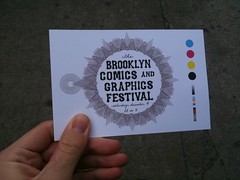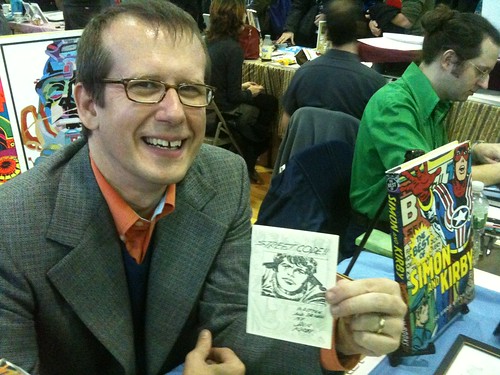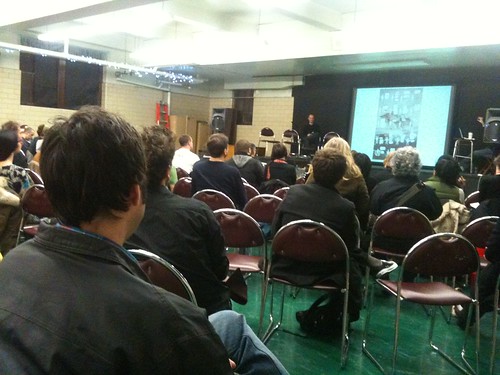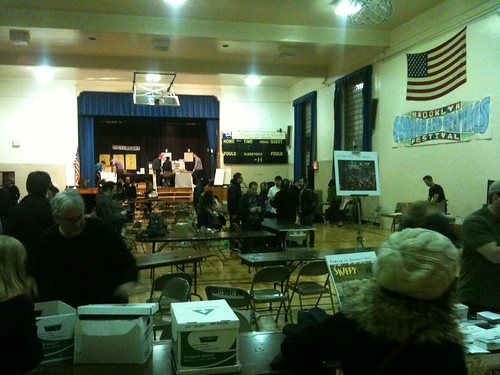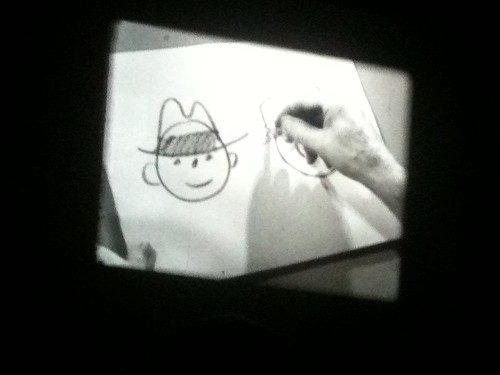"Superman: Earth One" from DC Comics
Penciler Shane Davis said that to me when I interviewed him early last month at New York Comic-Con. I suspect that we, as humans, are designed to only believe that which we see before our eyes. That is why the promotional tagline for the 1978 "Superman: The Movie" was "You Will Believe a Man Can Fly". But Superman is a do-gooder. He makes the choices we all think we would make thrown into extraordinary circumstances. Often without reservation or hesitation. As Bradford Wright said in
the History Channel documentary "Comic Book Superheroes Unmasked": "We couldn't accept a goodie-goodie coming down and doing things just because they were good, but we could accept somebody who felt some twisted emotional need to fight evil." The question has been raised: 'How believable is that "goodie-goodie"?' J. Michael Straczynski's and Shane Davis' graphic novel "Superman: Earth One" attempts to give us new answers in a new story unburdened by either old Superman stories or the 22-page monthly comic-book format. Possibly even as a first step toward an ongoing series of graphic novels with the gravitas of something like a big-budget film franchise.

The scope is certainly cinematic, in fact it's more like a Hollywood action movie than any comic I've ever read. That means it's exciting, action packed, smartly structured, and visually stunning, with just a splash of powerful emotion but it also means it all moves too fast leaving a few emotions, circumstances, and characters without full development. Clark Kent is introduced on page 1, he displays superpowers on page 5, we have a threat introduced on pages 37 to 45, fighting begins on page 74 and lasts until page 104. This threat, an alien invasion with ties to Clark's original home planet of Krypton, is (mostly) resolved and a status quo is established by the final page clocking in at 124. The people who interpreted the promotion and design to indicate a 'sensitive' Clark Kent, an emo Superman, just about couldn't have been more wrong: BIG explosions, punching, flying, and dramatic hero vs. villain talking moves along, broken only by flashbacks, for 60 pages. A little bit under half, but a little bit
too much for my liking.
That leaves only about 35 pages of pure character development. Just a third of the book, and a little bit
short for my liking. 'How sad,' I thought when I hit the 40th page of the graphic novel, flipped ahead, and saw that the quiet scenes were mostly behind me. We get 30 pages of character, 60 pages of fighting, and 20 pages of set-up for the sequel? Or so I thought. Amid those pages of superhero fighting in the skies of Metropolis there's 13 pages of very emotional flashback to Clark's babyhood on Krypton or
Smallville-style teenage years of being raised by Ma and Pa Kent in images and highly effective dialogue. OKAY, ENOUGH NUMBERS NOW. All of that should not stand against the simple fact that there is still more character moments than the average superhero comic.

The beauty of the story is in those flashbacks to Clark's conversations with Jonathan Kent. We're given some wonderful, sad, meaningful dialogue about growing-up, taking risks, and choosing your path in those snippets. "That's when we wake up. That's when we know who we are. That's when people will show up and take your side-- When you decide what it is you
stand for, when standing is the
hardest." Straczynski with all the headlights on, forging ahead into darkness. This is what I was looking forward to for the past year.
The beauty of the book itself is in the art: there are moments in here where Shane Davis' pencils and Barbara Ciardo's colors are at a caliber second to none. I compare it to John Cassaday and Laura Martin's work on
"Planetary". (Yes, THAT good.) The splash page of the little ship holding baby Clark as he shoots past collapsing buildings in the last moment before Krypton's destruction. Davis and Ciardo firing on all cylinders, making other worlds appear. That is the thing I didn't predict I would love so much.
And the moments in which the storytelling synergy of script and pencils come together: Clark flies in a series of relative POV panels all the way into the stratosphere, the moment Superman wakes up in free-fall remembering his father's words encouraging him to "fly". They are magnificent.
But there are moments where it didn't all come together for me. Moments that were a little too easy. Dramatic, but over-played. Clark becoming a reporter for
The Daily Planet at the end, putting on the suit for the first time in the middle:

That said, I think the final effect is that we do have the most believable Superman we have ever seen in a comic. And, as a direct result, the most heroic. He does make difficult decisions about his purpose and you can imagine a young man in his position making his choices. He must make a choice with the possibility of sacrificing what he wants personally for what he perceives is needed in the world according to his ability. And when he puts his own needs aside to make those choices, a financial, social, and emotional sacrifice is made. My generation is making that decision every day. Clark Kent really becomes a SuperMAN. Jimmy Olsen is replaced with James Olsen and this new grown man of a character speaks some inspirational words. (This is amazing if you've seen enough 1940s-50s Superman comic-book covers.) Olsen almost steals the show. Perry White is a newspaperman in a world of dying newspapers. He refuses to give up. Lois Lane seems, to me, to be the owner of the short end of the stick. She seems the same.
The question of whether an out-of-continuity graphic novel implying a series of new-continuity graphic novels featuring a well-known superhero could sell enough to warrant those sequels actually being greenlit
has been answered. Another Superman Earth One graphic novel will arrive and the sales numbers have been clearly stated as the reason. [via DC: Source blog] And the Long and Shortbox Of It would like to congratulate J. Michael Straczynski and Shane Davis for those sales and being allowed to continue this project together because of those sales numbers.
But is the comic good?
There is no question that what has been created here is a full-length work, a movie on paper, a novel in pictures: a graphic novel by just about any definition you can throw at it. It's over 100 pages. It has a beginning, a middle, and an end. It was created and published in one push by a single creative force consistantly responsible for what is on the page. It depicts a character in a moment of true emotional difficulty and growth. It stands as a work by itself, but with the potential for sequels and prequels. My answer to whether or not the graphic novel was good is: Yes. It is in fact, great. But no, it is not exceptional. Being a graphic novel, it competes on a different playing field against things like last year's
"Asterios Polyp",
"Blankets", and
the Scott Pilgrim series but it opens up new worlds of possibilies.
More high quality graphic novels from Marvel or DC, either with superheroes or other genres, featuring established characters or new ones, in-continuity or out-of-continuity?
Possibilities I look forward to. And in the meantime, we have a beautiful Hollywood-style graphic novel in "Superman: Earth One".
~ @JonGorga
 All that said, Zachary Kanin's short and jocular adaptation of the story of Noah and the flood is far from bad. It's light and fun material and any fan of either Bill Cosby's or Eddie Izzard's hilarious stand-up bits recounting the story of Noah will find much to enjoy here. Kanin packs a lot of great stuff into four pages. Stuff like the two panels in which Noah is revealed to be a nose picker and the narrator declares "Well, not totally righteous" followed immediately by a panel where God says: "But good enough!" The effect is a bit of humanizing while poking fun at a Biblical figure.
All that said, Zachary Kanin's short and jocular adaptation of the story of Noah and the flood is far from bad. It's light and fun material and any fan of either Bill Cosby's or Eddie Izzard's hilarious stand-up bits recounting the story of Noah will find much to enjoy here. Kanin packs a lot of great stuff into four pages. Stuff like the two panels in which Noah is revealed to be a nose picker and the narrator declares "Well, not totally righteous" followed immediately by a panel where God says: "But good enough!" The effect is a bit of humanizing while poking fun at a Biblical figure.


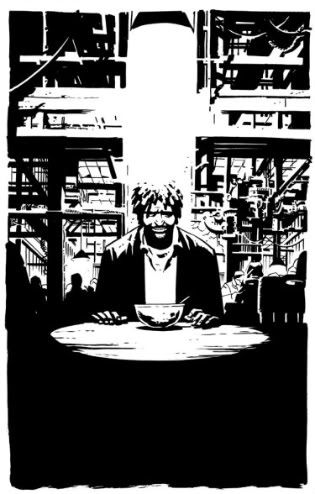






 On display at the Kentler is
On display at the Kentler is 

